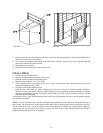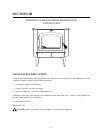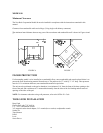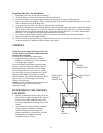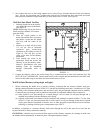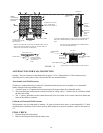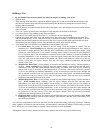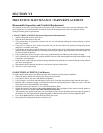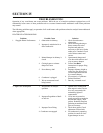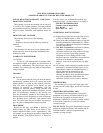
SECTION VI
PREVENTIVE MAINTENANCE / PARTS REPLACEMENT
Disassembly Inspection and Catalytic Replacement
The catalysts in your stove are designed for many years of use. If after several years of use, the efficiency of the
stove decreases or if a notable amount of smoke is observed, the catalysts may need to be replaced. See the
Catalyst Warranty prior to replacement.
CATALYST REPLACEMENT (Off-Season Replacement Recommended)
1. Spread a drop cloth in front of the stove.
2. Open the door and clean out any ash.
3. Using penetrating oil, generously lubricate the four (4) bolt threads holding the catalyst housing in place.
Allow to penetrate.
4. Using a 9/16" wrench or 9/16" socket, loosen the four (4) nuts and remove the catalyst housing (drop down)
and place in a suitable work area.
5. Using needle nose pliers, grasp the front edge of the stainless steel “can” which houses the catalytic element
and pull upward. Reposition pliers to another position and pull upward. Repeat procedure until the catalyst can
be removed from the housing.
6. Using a small putty knife or scraper, remove any gasket that may have adhered to the catalyst housing.
7. Now, obtain the new catalyst and wrap the stainless steel can with interam gasket and tape ends together using
scotch tape or masking tape.
8. Insert the new catalyst into the catalytic housing and push down until they are seated on the top of the stainless
steel wire mesh supports.
9. Reinstall the catalyst housing into the stove and secure in place with the bolts.
10. The stove is now ready for use.
GASKET REPLACEMENT (Cold Heater)
To replace deteriorated gaskets, the following steps must be taken to ensure proper installation:
1. Obtain the proper gaskets and silicone glue from your local dealer.
2. Using pliers, remove any worn and deteriorated gaskets.
3. Using a scraper, wire brush, and sand paper or steel wool, clean glue and gasket residue from the door frame.
4. Measure and cut gaskets to length. Care should be taken not to stretch the gaskets. What you want is a full and
loose gasket weave after attached to the framing.
5. Obtain the silicone glue and run a 3/16" bead inside the door frame.
6. Obtain the gasket(s) and place in the gasket channel areas. Use a technique which assures that the gasket is
applied in a loose like manner. DO NOT STRETCH GASKETS.
7. After gasket(s) are applied to the glue, use your finger and go over all the gasket gently pressing the gasket to
the channel. Use the same pressure against the gasket so that the final result is an evenly applied gasket.
8. Leave door open and allow at least one hour for the glue to dry.
9. Once gaskets are checked, the heater is ready for use.
21



